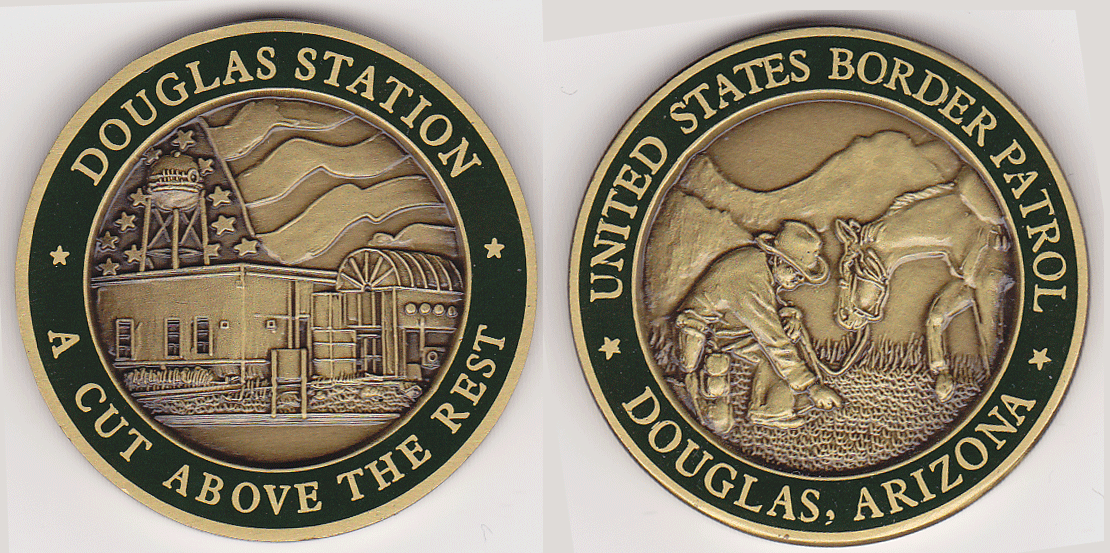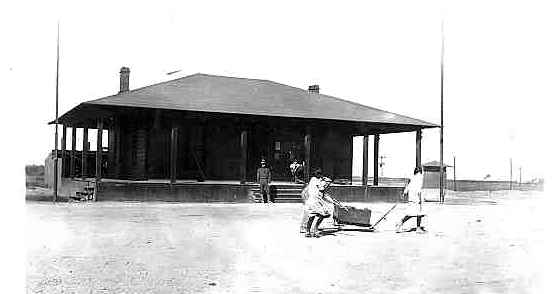This page is a stub -
You can help complete it

The city of Douglas, Arizona, was established in 1901 when the
Phelps Dodge Company decided to locate a copper smelter on the banks of
Whitewater Draw in southern Cochise County. With its close proximity to
the border, relative lack of law enforcement, and the politically
unstable conditions in Mexico, Douglas quickly gained a reputation as a
wide open, "anything goes" town. The problem was brought under control
through better municipal organization coupled with the efforts of
Captain Tom Rynning and his Arizona Rangers. In 1902, Captain Rynning
moved the headquarters of the Arizona Rangers to Douglas because the
majority of the problems being encountered by his 30 man Ranger force
were in this area. He later stated, "I've been in many a tough town in
my day from Deadwood to Tombstone, but I've never met up with a harder
formation than Douglas was when we made it the Arizona Rangers home
corral there in 1902."
 |
| Original Douglas Arizona border inspection
station, as seen in 1916 |
Douglas still maintains a reputation as an
"anything goes" town where the illicit trafficking of illegal aliens and
narcotics is concerned. On May 28, 1924, Congress passed the Labor
Appropriation Act of 1924, officially establishing the U.S. Border
Patrol for the purpose of securing the borders between inspection
stations. They mandated that Douglas be one of the initial locations for
posting the new personnel who were then called Border Patrol Inspectors
rather than Agents. Prior to the establishment of the Patrol, Mounted
Inspectors performed the double duties of manning the Douglas Port of
Entry and "line riding" on horseback.
In the 1930's, Douglas was
increased to an authorized staff of 18 inspectors. However, usually less
than 12 were in force. The first station was located at International
Avenue and Pan American Avenue. The one-story wooden structure housed
Customs and Immigration. In 1932, a new port of entry was constructed
and the old wooden structure was moved by railroad flatcar to 21st
Street in Douglas where it now serves as a two family residence. The
Border Patrol maintained its office in the new Port building until
December 16, 1987 when it moved into a new, modern complex located at
Leslie Canyon Road and Lawrence Avenue. Construction of that complex
began in 1986 and was completed in 1987 at a cost of $1.2 million. The
main building encompasses 4,500 square feet of space in southwestern
design. The garage, at 1,200 square feet, contains five mechanical bays
and two vehicle hoists.
The Douglas Border Patrol made one more
move in 2003 to its current location at Highway 80 and Kings Highway.
The notice to proceed with construction for the new Douglas Border
Patrol Station was issued in December of 2000. Actual construction began
shortly afterwards. The facility was built on 29 acres of seized
property and was completed in March of 2003 at a cost of $23 million.
The Douglas Station is one of eight stations in the Tucson Sector
that ensures the successful implementation of the service's Southwest
Border Strategy. The Douglas Station's area of responsibility (AOR)
covers 40.5 linear miles of the International Border with Mexico and
includes over 1450 square miles of mountainous terrain, with a few small
valleys to the north of the International Border.
In April, 2017,
a cross-border tunnel was discovered, which showed no signs of recent
use and was collapsed about 25 feet from its opening, but is thought to
have been used to smuggle both humans and narcotics into the U.S.
See also:
Douglas, Arizona
|


